|

Promising times ahead for Sinhala cinema
Ruwini Jayawardana
Sinhala cinema had stood strong for many years, braving the storms
and shining through creative talents at international film festivals. A
fledging industry which had struggled to find its foothold, Sinhala
cinema had transformed itself from imitating its Indian counterparts to
establishing a local identity via productions like ‘Gamperaliya’, ‘Sath
Samudura’, ‘Weilkatara’, ‘Bambaru Awith’ and many more. This was the
golden era of the reel when stars where born and many evergreen projects
made.
|
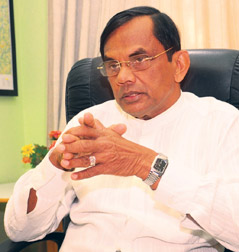
NFC chairman Asoka Serasinghe. Picture by Lalith C Gamage |
As the shadows of death and destructions clouded the horizons through
the three decade terrorist period, the local cinema industry came to a
standstill. It was only efforts made by a handful of film-makers which
kept the industry from dying away. Productions like ‘Aba’, ‘Ira Handa
Yata’ and ‘Mahindagamanaya’ brought masses back to theatres. With more
and more seasoned and skilled film-makers looking to make productions,
the years hold much more promise for the Sri Lankan cinema industry.
Sinhala cinema will be celebrating its 65th anniversary on January 21
and the National Film Corporation (NFC) will be 40 years old this year.
Daily News ‘Projector’ spoke to NFC chairman Asoka Serasinghe about the
developments of the cinema and plans for the industry in time to come
Q: This is your second term as the head of the corporation. What are
the new challenges that you have identified in the industry?
A: The situation is more comfortable than that of my previous term.
The socio economic situations are rather different when I left the
Corporation in 2007. Today everybody believes that the country has gone
into a peaceful atmosphere. This would be a very appropriate time to
improve the aesthetic sector. Everybody will see that the improvement of
the cinema industry also goes accordance to the other areas.

Kadawunu Poronduwa |
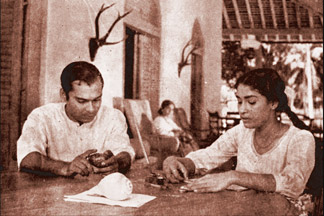
Gamperaliya |
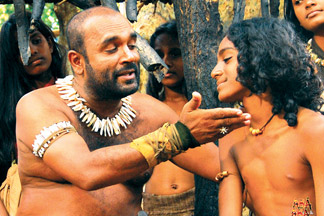
Aba
|
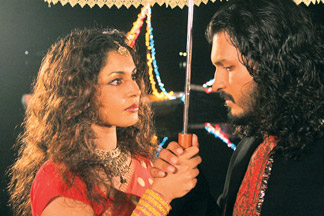
Akasa Kusum |

Ira Handa Yata |
During my last term I had a large amount of documents on my table to
requesting me to close down cinema theatres. Today I get many more
documents seeking permission to reopen or construct new theatres.
The people are also stepping into theatres these days. Doors closed
on the industry especially in areas such as the north east area when the
battle was proceeding. Theatres were broken down and abandoned. The
people in these areas did not get a chance to watch a film for years.
Now some of these theatres are functioning again. Appeals are being made
to reconstruct theatres available in the zone and build new theatres. I
am enthusiastic about the change. I have a clearer path to go ahead with
my work and develop the sector.
Q: Most of the films which are being made and screened nowadays deal
with terrorism and the postwar situation. Do these give a clear picture
of the incident or do you see it as a propaganda?
A: That is a very complicated question. My personal opinion is that
it is best to forget the whole episode but unfortunately film-makers
believe that there will be a market for war. We are grateful to
President Mahinda Rajapaksa, the three forces and all those who worked
towards vanquishing terrorism but why should we bring it into the film
industry? On the other hand people who have no first had experience of
the war are very inquisitive. They go to see the events unfurling on the
screen to see a similar situation taking place. However this is a
limited audience. Apart from war, history is the other prominent
attraction. For the past few years this had remained an ignored topic
but now there is a big market for historic productions. ‘Aba’ and
‘Mahindagamanaya’ proved this point. ‘Kuveni’ will come to theatres
soon.
I do not know how far the producers study the market and decide that
the war is a marketable element. If they cannot develop strategic means
to cater these creations to the audience they had better focus their
attention on another area.
If you do not study the market when you engage in a project, your
production would fail. Film-makers do not do a market study before make
a movie. They make movies based on their personal agendas or to satisfy
other parties. They are least concerned about the general audience.
Q: What is your definition of the cinema culture of Sri Lanka?
A: A custom originates from the roots of the society. If it is
exposed and received well it becomes part of the culture. Likewise if
cinema entertains only a few people, we cannot develop a culture. We
need to cater the productions to masses. For that we need to identify
the requirement of the majority.Film is generally a popular culture. For
example Chennai citizens need to see action packed movies with fights,
violence, bloodshed and the hero overpowering the villains. In Hollywood
we see science fiction, action and sex scenes.
We need to identify our culture to build a film culture. The common
perception is that we have a Sinhala Buddhist culture. The present
market for films is related to history and religion.
Q: The NFC has been accused of donating funds for movies which lack
aesthetic value. Where do you draw the line in selecting the films for
this purpose?
A: There is a problem in how we are going to categorize the films
because it is vast and complicated. One person could judge the creation
according to artistic standards while the other could categorize it
according to the commercial viability.
We assist directors even if a film is not artistic but can bring on
the money because our main concern is to uplift the industry. The
categorization does not carry any specific measurements. However there
are restrictions. The film needs to make some money for the betterment
of the society and industry. As long as it does not give an adverse
input to the public, we assist the project.
Q: Aspiring film-makers have been given scholarships to study cinema
abroad in the past. Later the process came to a standstill. Will it be
implemented again?
A: We have a study course for those who wish to step into the
industry. We are holding a short film competition and select the best
out of the lot. We also deal with foreign agencies to assist them in
improving their knowledge. I sponsored Sanjeewa Pushpakumara, who made
‘Igillena Maluwo’, to study cinema in Korea during my first term.
Unfortunately film is not a very established industry in Sri Lanka
when you compare it with other sectors. Therefore there are less venues
open for directors to benefit and excel in their field. I signed an
agreement with China during my first term which allows Sri Lankan
directors the opportunity to get scholarships and training in China. I
hope to renew that alliance.
Q: What is your key focus at the moment?
A: I have a very isolated single target. Have you heard any Sri
Lankan film which had been exhibited overseas and brought a single
dollar or rupee to the country? Our films have been acclaimed at
international film festivals and had won a number of awards but not a
single Sri Lankan film had been shown to a foreign audience with the aim
of bringing money to the country.
I took steps to solve this matter during my first term but the
projects came to a halt once I left the seat. I signed a mutual
agreement with the Chinese film industry as a part of a film exchange
project. We would be screening some of their movies in Sri Lanka while
they would screen some of our films in China.
The other was a pact with the Gemini Corporation of India. Gemini is
the most prestigious film company in India. They make Tamil and
Bollywood films. They signed an agreement with me to produce a joint
project and exhibit 10 copies of the film in their theatres. The
agreement still exists and I want to rejuvenate the project. Gemini is
keen on the project and had visited Sri Lanka several times to implement
the project. Unfortunately my successors did not take any interest. Now
the time is ripe for me to relaunch these projects.
Q: What are your plans for the industry in 2012?
A: We are at the last stages of celluloid films. We are stepping into
the digital era. Around 16 films have already been done in digital and
ready for release. We have given two temporary licenses for projection
systems to Majestic and Ricky cinemas.
More theatre owners are demanding for the license but unfortunately
the legislation does not permit us to give permission immediately.
The necessary amendments will be done and no sooner we get permission
we will allow digital projection facilities to be instilled in the
theatres.
We can cut down the cost by 30 percent if we make a movie in digital.
Directors, producers and theatre owners are enthusiastic about the idea.
This situation needs to be administered.
‘Matha’ on January 20
Credits
* Producers: Ruwan Jayasinghe, Sanath Lanka Ranaweera and Wijji
Rathnayake
* Director: Visvanth Buddhika Keerthisena
* Screenplay: Dr. Ariyarathna Athugala
* Cinematography: Milton Kam – USA, Donald Karunaratne, K. A. Dharmasena
* Art direction: Udayasiri Upatissa, Lionel Liyanage, Sampath
Wanniarachchi
* Editor: Stephean Philipson
* Music composer: Lakshman Joseph De seram
* Visual effect supervisor: Visvanth Buddhika Keerthisena
* Post production supervisor: Ravindra Guruge
* Special effects supervisor: Joe Van Kline
* Sound Editor: Aruna Priyantha Kaluarachchi
* Costume designer: Kumara Karawdeniya
* Makeup artist: Wasantha Vittachchi, Upul Mahanama
* Line producer: Nimal Wijesiri Senadheera
* Cast: Ravindra Randeniya, Darshan Dharmaraj, Yashoda Radhakrishan,
Kanakasabe Pavithran, Mallika Keerthi, Raja Ganeshan, Pragathi Varshani,
Mahendra Perera, Dharmapriya Dias, Thumindu Dodanthenna, Buddhika
Jayaratne, Dasun Pathirana and Gayan Perera.
----***
|
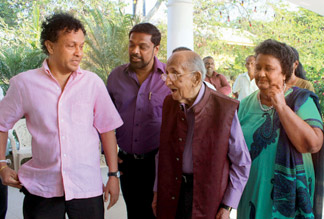
Prof Ariyaratne Athugala, Dr Lester James Peries and Sumitra
Peries at the ‘Matha’ press show. Picture by Nissanka Wijeratne
|
|
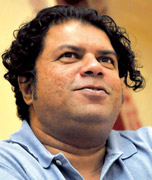
Boodee Keerthisena. Picture by Rukmal Gamage |
Vishvanath Buddhika Keerthisena's latest cinematic venture ‘Matha’
will begin screening at Colombo, Regal Cinema and other CEL theatres
islandwide soon. The film is based on a love story which takes place
within the battle between the forces and the LTTE.
It captures the emotions of Yoga and Parwathi on screen amid the
horror of the bombings and shooting between the two groups. The film
reveals how the struggle that the two sides endured to overpower each
other and be the last one standing.
Yoga, a child soldier for the LTTE, tries to escape from the force
but fails. He is separated from his young love Parwathi when a bomb
explodes on a train. Around 15 years later, he meets her again on the
battlefield of the Sri Lankan civil war. He finds out that she was an
English teacher, but had to join LTTE to stop them from forcing her kid
brother to become a child soldier. Meanwhile, Parwathi's mother, father
and young sister are among the 300,000 Tamil civilians who were
displaced by the LTTE (many by force).
War gets intense and Parwathi's family get scattered through all the
complications and hardships the refuges endured. Yoga and Parwathi keep
getting separated and reunited in the boated battles between the Sri
Lankan army and the LTTE.
Parwathi finds out that she is pregnant with Yoga's child, and tries
to find him. They reunite again, and she tries to convince him to run
away with her for the sake of their unborn child. But in the last stage
of the battle, they are surrounded by government forces that are on a
mission to rescue the civilians from the LTTE. Yoga has no hope and
tells Parwathi that if the LTTE finds out about her pregnancy they will
be killed, but if they are caught by the army they will be shot too.
This is the story of Yoga and Parwathi seen through the days of war in
Sri Lanka.
Towards a local cinema identity
Nipuni Wimalapala
Sirisena Wimalaweera is one of the pioneering figures in Sri Lankan
cinema who has taken steps to establish a home grown native cinema
industry. He wanted to escape the trend of excessive imitations which
was instilled in local cinema during his era. A competent film-maker and
an expert on the subject, Wimalaweera understood the pulse of his
audience.
|

Shiranthi Wimalaweera. Pictures by Rukmal Gamage |
|

Daya Wimalaweera |
A felicitation ceremony will be held at the National Film Corporation
on January 22 at 4 pm to appreciate Wimalaweera’s contribution to the
local cinema industry. Prof. Sunil Ariyaratne will conduct the memorial
oration on the day.
Two films directed by Wimalaweera, ‘Pitisara Kella’ and ‘Asoka’ will
be screened in the morning on the same day. After the memorial oration
‘Ma Alaya Kala Tharuniya’, another film by Wimalaweera, will be
screened.
Speaking to Daily News ‘Projector’ Daya Wimalaweera, the son of the
late Wimalaweera recalled the memories of his father’s golden era.
“Initially he chose a totally different field. He went to India to
study ayurvedic medicine but ended up learning cinema. He realized that
is where his talents lie and he will be able to excel in the field,”
Daya said.
“My father was the first to establish a cinema which goes beyond
imitating the styles and techniques adapted by other countries.
He started his career from the stage and then entered to the silver
screen. He was fluent in many languages such as Sinhala, English, Tamil,
Bengali etc. He has worked with many Indian artistes,” he explained.
Wimalaweera’s first drama ‘Prathaf Sing’ was staged in 1926. His
first cinematic creation, ‘Amma’ was released in Central Cinema,
Maradana, in 1949. D R Nanayakkara, Ferl Wasudeva and Edi Junior started
their acting career with this film. His second film was ‘Seedevi’ which
was released in 1951.
“The highlight of my father’s career was the establishment of the
first Sri lankan Studio Jeewana in Kiribathgoda. This helped a lot of
local artistes to exhibit their talents. My father produced the first
film there. It is titled ‘Pitisara Kella’. He later produced many other
films such as ‘Saradiel’, ‘Asoka’, ‘Podi Putha’, ‘Sirakaruwa’, ‘Ekamath
Eka Rataka’, ‘Ma Alaya Kala Tharuniya’ and ‘Wana Mala’ at the same
studio,” Daya noted. In 1956 Wimalaweera won the Deepa Shika award for
his film, ‘Podi Putha’. It was the only award he won throughout his
cinema career. He was an artiste who wanted to give a meaningful
production to the audience without being limited to the entertainment
zone.
Daya is the eldest son of the late artiste and followes his father’s
footsteps in his passion for cinema. He has produces films such as
‘Weeduru Gewal, ‘5.45’, ‘Jeewana Kandulu’, ‘Meedum Sihina’, ‘Major Sir’,
‘Dew Duwa’ and ‘Sujatha’. Daya’s daughter, Shiranthi, is the grand
daughter of the late Wimalaweera. She too shares an interest in the
field.
Recollecting memories of her grand father, she mentioned that
Wimalaweera was a towering figure in Sri lankan cinema and his works
were exceptional. “He was the master who introduced most of the veteran
artistes in the country to the silver screen. Patriotism was one of his
most prominent characteristics. He wanted to establish an indigenous
cinema industry” she said.
|



